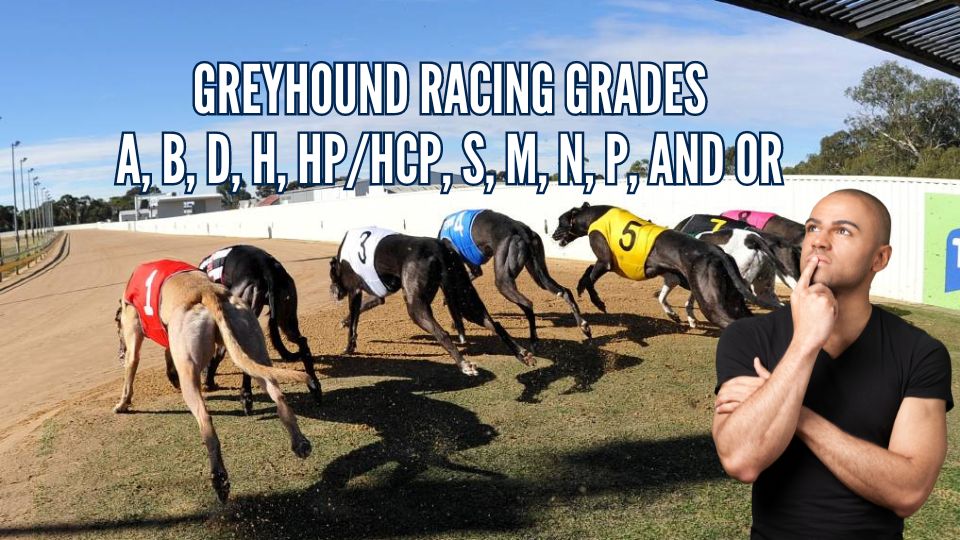Greyhound racing grades are a hierarchical classification system that categorizes dogs based on their skill levels and accomplishments, providing a structure for fair competition and enabling racers to advance, peak, or descend in grades according to changes in their performance throughout their careers. This classification is not merely about ordering races based on distances, but it involves understanding the intricacies such as the track’s standard distance, the experience level of the dogs, and even the presence of hurdles or obstacles. Let’s explore nine primary race codes – A, B, D, H, HP/Hcp, S, M, N, P, and OR – and decode the various greyhound racing grades they represent.
Middle Distance Races: The Familiar Standard
Middle distance races, recognized under two letter codes – A and B, comprise a substantial portion of the greyhound races. These challenges encapsulate a range of 380m to 500m, making them the most ubiquitous race type.
Grade A events are frequently synonymous with standard races, being prevalent in the greyhound racing circuit. However, an intriguing and often overlooked nuance is the Grade B middle distance races. Though they sit within the same 380m to 500m range, the unique aspect is the track’s standard distance that has been slightly adjusted.
The Swift and Sharp: Sprint and Hurdle Races
When speed joins strategy, we get grades like D and H. Called sprints, Grade D races are traditionally shorter, within 200m to 350m, and generally incorporate only two of a track’s four bends. These races are about raw speed and a greyhound’s ability to tear away from the gate at unmatched velocity.
On the contrast, we find Grade H, the hurdle races, which are concerned more with agility. Here, the dogs are confronted with low obstacles that they must traverse, adding another layer of complexity and excitement.
The Test of Stamina : Handicap, Stayers and Marathon
Endurance forms the backbone of the grades HP/Hcp, S and M. The HP/Hcp handicaps are an interesting twist to the standard races, where the starting stalls are staggered, allowing the slower dogs a strategic advantage by providing them a head start.
The Grade S stays races, spanning 600m to 700m, demand more from the greys than the standard middle distance. Then we travel further down the scale to the stamina-sapping Grade M marathon races, contested over sweeping distances of 800m to 1000m.
The Special Categories: Novice, Puppy, and Open
The final categories, represented by N, P, and OR, come with a distinct flavor.
The Grade N novice races are tailored for those dogs that are either unraced or very inexperienced. Providing a platform for these promising greys to gain crucial experience and knowledge.
Grade P, otherwise known as puppy races, are specific contests for dogs aged between 15 and 24 months. It’s an excellent way to observe young talent in action before they move on to older and more experienced circuits.
Finally, Grade OR open races. These are high-class events that consist of dogs from several different tracks. They offer a great opportunity to compare the level of talent and strategy across tracks and are some of the most exciting contests in greyhound racing.
Understanding the various greyhound racing grades not only enriches the enjoyment of the sport but also contributes to better communication, strategic wagering, and even breeding considerations. It provides a nuanced perspective that allows you to appreciate the skill, speed, and endurance of these sleek and agile athletes.
Grading and Classifications in Greyhound Racing
In the dynamic sport of greyhound racing, different grades and classifications are necessary for arranging contests and distinguishing competitive categories. The grading divisions for each race are designed to represent the diverse speed levels exhibited by these agile dogs.
This article broadly explores the grading divisions and classifications across different race types, including middle-distance, sprinting, and staying races, along with a comparative understanding of the talent pool within these categories.
Grading Divisions: The Scale of Speed
The grading divisions in greyhound racing serve to cater to the varying speed levels of the dogs. Each race type implements a unique grading system:
- Grade 1: Represents the swiftest dogs in any given race type.
- Grade 2: Contains dogs with speeds slightly slower than those in Grade 1.
- Subsequent Grades: Continue to showcase progressively slower dogs.
The classifications sequence within each race type starts from Grade 1 for the fastest dogs and goes down as the speed of the dogs decreases.
The A Category: A Spectrum of Talent
The “A” category is of particular interest due to its extensive talent pool and broad spectrum of grading divisions:
- Starting point: Begins at A1, housing the most adept and talented runners.
- Scope of grades: Extends all the way down to A11, for the slower dogs.
While the large number of individual grades within the “A” category might seem overwhelming, this variety aids in structuring races and ensures less overall variation between the runners in each grade. It promotes a more even and fair competition ground.
Fewer Grades in Sprinting and Staying Divisions
When observing the sprinting and staying divisions, a narrower pool of dogs is noticeable, which is reflected in the fewer number of grades:
- Sprinting (D category): Encompasses D1 to D6
- Staying (S category): Includes S1 to S6
In conclusion, understanding the connection between the grades, classifications, and race types enables strategies in selecting suitable events for dogs based on their speed levels, ensuring fair play and competitiveness in each race.
| Race Type Category | Grade Scope | Description |
|---|---|---|
| A | A1 to A11 | Covers a wide range of greyhound speed levels. |
| D (Sprinting) | D1 to D6 | Features fewer grades due to a smaller pool of greyhounds. |
| S (Staying) | S1 to S6 | Similar to sprinting, has fewer grades due to a smaller number of greyhounds. |
The diverse grading system in greyhound racing enhances the complexity of the sport and bolsters the intrigue for enthusiasts worldwide.
Open Races: The Apex of Greyhound Racing
Open Races (OR), standing at the pinnacle of the greyhound racing grading ladder, delineate the elite competitors in the sport. These battles of speed serve as the ultimate contest for the finest Grade 1 canines, occupying a distinct category elevated above the standard grading scale.
Subdivisions in Open Races
Aligning with the hierarchical layout of Group and Graded races in horse racing, the Open Race category further divides into three sections:
- OR1: Houses top-tier races such as the Puppy Derby and the illustrious English Derby.
- OR2: Mid-level competitions with substantial prize money.
- OR3: Lower level of Open Races but still exalted compared to standard graded races.
These three subdivisions combined form the Major Open Race category, acclaimed as the most prestigious events in the sport.
Prize Money in Open Races
Open Race contests consistently hold a dominant position in terms of prize money, outclassing standard graded events, and occasionally by exceptional margins. The tables below provide a glimpse into the potential winnings in Open Races:
Major Open Race Prize Guide
| Grade | Prize Money Example |
|---|---|
| OR1 | Puppy Derby £25,000, English Derby £175,000 |
| OR2 | Up to £6,500 |
| OR3 | Minimum of £800 up to £1,800 |
Minor Open Race Prize Guide
| Race Category | Prize Money |
|---|---|
| Minor Open | Minimum of £100 to the winner |
Thus, the segregation of open races into these tiers not only further refines the classification of talent but also influences the purse each canine is racing towards, adding further excitement to this sport of speed and endurance.
Comparative Analysis of Speed in Greyhound Racing Grades
Discerning the subtle speed differences between greyhound racing grades can present a challenging endeavor. While only a margin of approximately 4mph separates the fastest runners from the slowest, it contributes to a significant distance of 3.75 to 5 meters over the duration of a standard race. This section examines the peak speeds achieved by runners across different middle-distance race grades.
Speed Disparity Among Grades: The Devil in the Details
By the sheer observation of the naked eye, one might conclude that the vehemence of a greyhound’s sprint is similar across all grades. However, factoring in reliable speed measurements shatters this seemingly plausible assumption.
- Speed Variance: Despite sounding negligible, a speed difference as little as 4mph between the quickest and slowest runners plays a considerable part in deciding the race outcome.
- Impact on the race: This difference manifests itself in an estimated distance gap of 3.75 to 5 meters over a standard race.
These factors underline the importance of understanding and analyzing the correlation between the grade of a greyhound and its top speed.
Top Speeds Across Middle-Distance Race Grades
Dissimilar racing grades exhibit varying top speeds from the participating greyhounds. A general guide that delineates this speed difference is summarized in the table below:
| Grade | Top Speed (mph) |
|---|---|
| A1-A3 | 38-41 |
| A4-A6 | 37-38 |
| A7-A11 | 35-37 |
From the data, it can be inferred that top speeds in middle-distance races decrease gradually from the elite A1-A3 grade, reaching the slowest speeds in the A7-A11 grade category.
The correlation between greyhound grades and their top speeds adds an empirical perspective to the thrilling spectacle of the sport, unifying precision with vitality, and ensuring fair match-ups and intense rivalry in the race towards the finish line.
Greyhound Racing Lifecycle: A Journey Through Grades
Typically, greyhounds’ racing trajectory involves navigating through various grades at different stages of their athletic careers. New entrants in the competitive world of greyhound racing usually begin in the lower grades, advancing as they reach peak performance age, and eventually moving down through the grades as they transition to the veteran stage.
Career Inception: The Starting Grades
The commencement of a greyhound’s racing career is marked by their entry into professional races:
- Starting Grades: Most runners initially compete in the A7 to A11 grades, which are designed for relatively inexperienced and slower canines in the racing arena.
- Gradual Progress: Successes in these starting grades serve as the stepping stone for the greyhounds’ progression to higher grades.
Peak Performance Age: The Race to the Top
The physical peak of a greyhound, which usually occurs around 30 to 36 months of age, corresponds with their prime racing capabilities:
- Age Factor: The peak racing age varies slightly depending on the race category, with sprinters peaking a bit earlier and stayers reaching their prime slightly later.
- Upwards Progression: During this peak performance period, greyhounds often ascend to the top grades, signifying their finest racing form.
Veteran Stage: The Descent Through Grades
As the greyhounds grow older and enter the veteran stage, they tend to recede from their prime form:
- Performance Shift: With advancing age, the canine’s racing capabilities start to wane, mirrored by a descent through the grades.
- Veteran Stage: Typically characterized by a decline in top speed and stamina, this stage sees greyhounds gradually moving down the grading ladder.
This lifecycle journey through the grades underscores the dynamic and cyclical nature of a greyhound’s racing career, characterized by rise and eventual decline in their racing prowess, painting a holistic picture of the adventure that awaits these highly trained athletes in the competitive world of greyhound racing.
Assigning Starting Traps in Greyhound Racing: A Strategic Perspective
In greyhound racing, an imperative facet to understand is the strategic method employed for assigning starting traps. Unlike horse racing, where draw dictates starting stalls, greyhound racing assigns boxes based on each canine’s distinct running style, aiming to avoid collisions and facilitate a cleaner race.
Starting Traps: Aligning with Running Styles
For every greyhound race, the allocation of starting boxes correlates directly with the hounds’ unique running patterns:
- Box Allocation Principle: Each greyhound is methodically assigned a starting box designed to match their specific running style. It is unlike horse racing in which the starting positions for each competitor are determined by draw.
This distinct starting trap assignment strategy sets the stage for the initial burst of action once the race begins.
Chasing Styles: Varied Pursuit of the Hare
As soon as the stalls open, all greyhounds begin their pursuit of the hare. However, the method by which they chase it varies from one dog to another:
- Rails Runners: Some hounds prefer to remain close to the inside rail.
- Wide Runners: Some greyhounds tend to drift towards the outer side of the track.
- Middle Runners: Many dogs like to maintain their position in the track’s centre, or have no apparent preference for a specific route.
To minimize potential mishaps during the race, boxes get assigned based on these preferences:
- Allocation Procedure: Inside or rails runners are always assigned box 1 or box 2, wide runners are placed in box 5 or box 6, and middle seeds are allocated box 3 or box 4.
The strategic assignment aims to keep in-running incidents to a minimum, although traffic problems remain an inherent part of greyhound racing.
Exceptions: Open Race Competitions
However, certain situations necessitate deviations from the standard box assignment rules:
- Open Race Scenario: In the concluding stages of open race competitions, such as the Greyhound Derby, if multiple racers share the same running preference, it is inevitable that some will have to race from a non-optimal starting box.
This exception serves as a testament to the dynamic nature of greyhound racing, where not all factors can be controlled or standardized, adding an extra layer of unpredictability and excitement to this adrenaline-pumping sport.




